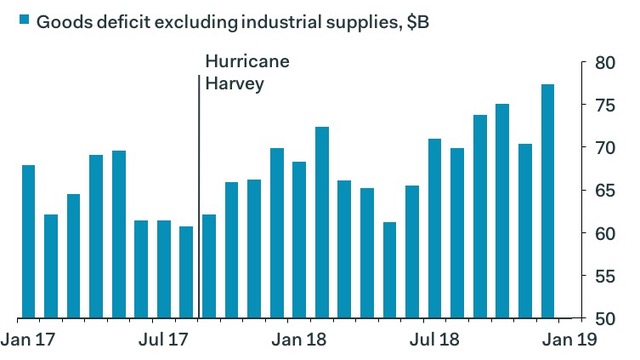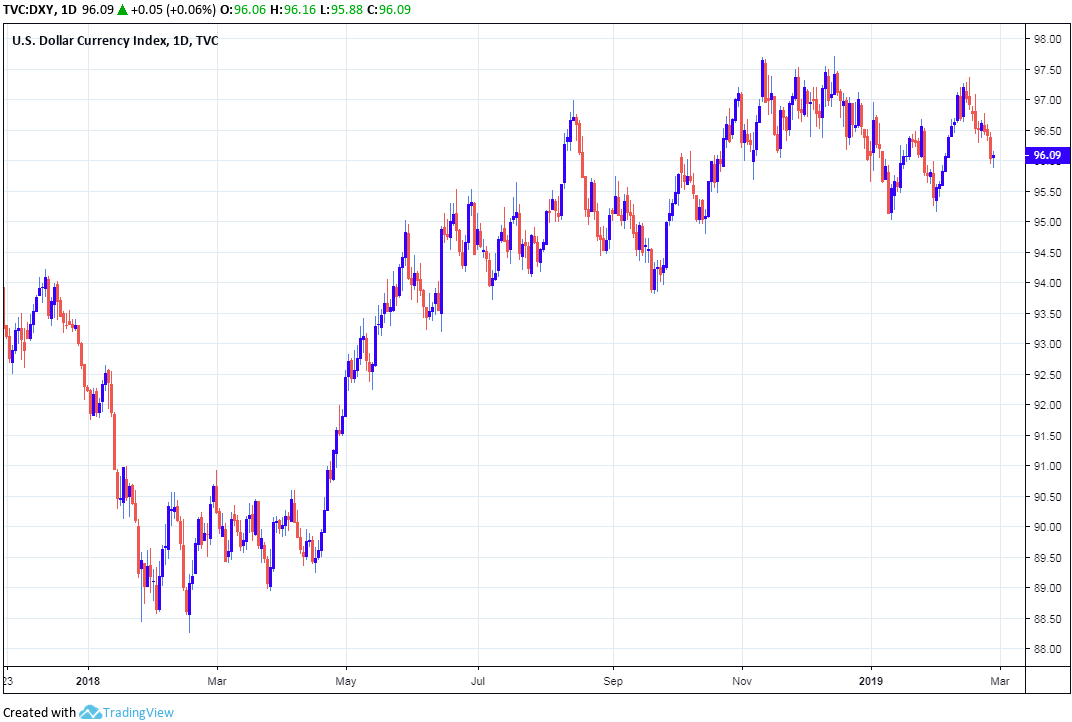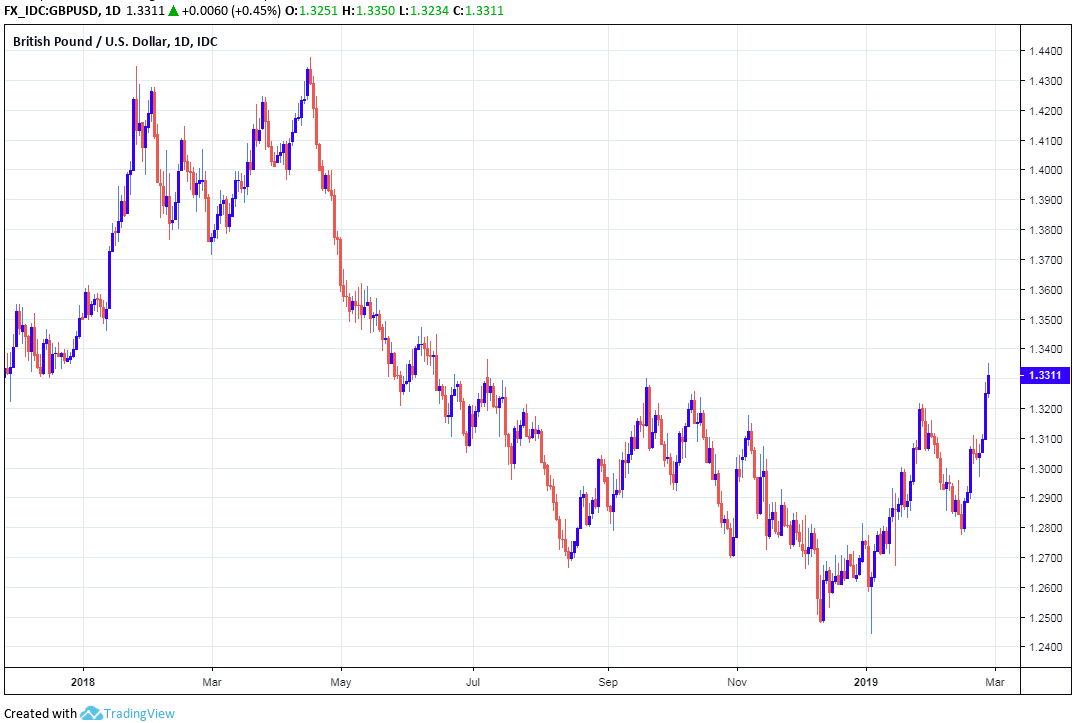U.S. Dollar Casts Nervous Eye toward Looming Q4 GDP Data after Trade Deficit Hits Record High
- Written by: James Skinner

© Robert Cicchetti, Adobe Stock
- USD eyes looming GDP data nervously after trade deficit shocker.
- Deficit hit record high in December, will weigh on Q4 GDP growth.
- Comes amid forecasts of U.S. slowdown and USD decline in 2019.
The Dollar could be stopped in its tracks when final-quarter GDP data is published this week after official figures revealed on Wednesday that the U.S. trade deficit surged to a record high back in December.
Economists say the record trade deficit was so large that it is likely to have reduced economic growth in fourth quarter of 2018, which could see the greenback stopped in its tracks because markets may see it as a sign of the economy coming back down to earth after being boosted by last year's tax cuts.
That being said, it still might not be enough to trigger a turn lower by the U.S. currency because the economic picture elsewhere in the world is even worse than that over in the U.S., particularly in Europe, so investors are short of alternative developed world currencies they can swap their Dollars for.
"Data on container flows at major ports strongly suggested that November’s drop in the deficit had not been sustained, but these numbers are worse than we expected," says Ian Shepherdson, chief U.S. economist at Pantheon Macroeconomics. "The immediate consequence of these numbers is that estimates of fourth quarter GDP growth will be revised down, by about 0.4 percentage points."
The U.S. trade deficit rose by 12.8% to -$79.5 bn during December, up from -$71.6 bn in November, when markets had looked for an increase to only -$74.1 bn. The deficit widened after exports declined at year-end and as imports rose.

Above: U.S. monthly trade deficit. Source: Pantheon Macroeconomics.
Exports from the U.S. were down by $4 bn during the month, to $135.7 bn, while imports rose by $5 bn to a total of $215.2 bn. This is a problem because imports are a subtraction in the calculation of GDP while exports are an addition, and both are moving in the wrong direction.
"Two stories are at work in the trade numbers. First, the combination of relatively strong domestic demand, boosted by tax cuts and lower gas prices, coupled with softening global demand, is a toxic combination. Second, the threat of increased tariffs on imports from China appears to have prompted precautionary inventory-building," Shepherdson writes, in a note to clients.
Shepherdson could have a point about U.S. companies potentially having accelerated goods imports during December in order to get around a then-anticipated increase in tariffs levied against goods coming into the country from China, because U.S. wholesale inventories also rose sharply at year-end.
Wholesale inventories were up by 1.1% to $661.8 bn in December when markets had looked for an increase of only 0.4%. It was in December the White House gave China 90 days to agree a deal ending its "unfair trade practices" or face tariffs of 25% on around $250 bn of its annual exports to America.
"This won’t continue indefinitely, and some of it should reverse when a trade deal with China is signed. For now, though, the rate of increase of the deficit looks alarming, and it means that foreign trade was a drag on Q4 GDP growth," Shepherdson says.
GDP data covering the final quarter of 2018 will be released on Thursday at 13:30 London time and consensus is for the economy to have grown at an annualised pace of 2.6% during the period, down from 3.4% previously.
However, Shepherdson says that consensus is now likely to drift lower ahead of tomorrow's data. He has cut his own forecast down to just 1.9%, which is barely any more than what was achieved by the Eurozone economy for 2018 as a whole. Eurozone growth was 1.8% in 2018.

Above: Dollar index shown at daily intervals.
Thursday's data will come with investors viewing the G10 currency complex as a bit of an ugly contest. If the U.S. economy slows notably and in a sustained manner at the same time as Europe, the Antipodean countries and China continue to slow then it could lead to inertia in currency markets.
Traders bid the Dollar higher last year, driving the Dollar index from a -4% loss in the first quarter to a near-5% gain by year-end, because U.S. economic growth picked up sharply after President Donald Trump's tax cuts were implemented at a time when other economies were slowing.
That led investors to anticipate that the Federal Reserve would go on lifting its interest rate as other central banks sat on their hands. But in recent months analysts have increasingly advised that those roles are are close to reversing.
So far that reversal hasn't happened because economies in Europe and other parts of the world have slowed even further but Wednesday's data could bring judgement day for the Dollar a little closer.
For now, familiar ranges for Dollar exchange rates are holding but it would only take a handful of signs that an economic recovery is on the way in Europe for the greenback to turn lower.
The Dollar index was quoted -0.03% lower at 96.0 on Wednesday and has now declined by -0.02% for the 2019 year. The Pound-to-Dollar rate was 0.49% higher at 1.3324 and has risen 4.59% in 2019 while the Euro-to-Dollar rate was -0.10% lower and has fallen -0.73% this year.

Above: Pound-to-Dollar rate shown at daily intervals.
Time to move your money? Get 3-5% more currency than your bank would offer by using the services of foreign exchange specialists at RationalFX. A specialist broker can deliver you an exchange rate closer to the real market rate, thereby saving you substantial quantities of currency. Find out more here.
* Advertisement




